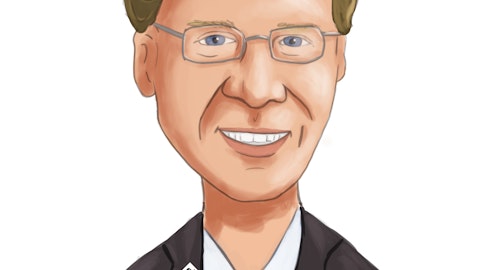West Bancorporation, Inc. (NASDAQ:WTBA) Q4 2023 Earnings Call Transcript January 25, 2024
West Bancorporation, Inc. misses on earnings expectations. Reported EPS is $0.29 EPS, expectations were $0.31. WTBA isn’t one of the 30 most popular stocks among hedge funds at the end of the third quarter (see the details here).
Operator: Good afternoon, and welcome to West Bancorporation Inc.’s Fourth Quarter 2023 Earnings Call. Please note that this call is being recorded. All participants are now in listen-only mode. After the speakers’ remarks, there will be a question-and-answer session. [Operator Instructions] Thank you. I will now turn the call over to Jane Funk, CFO. Please go ahead.
Jane Funk: Thank you, and welcome, everybody. Thank you for joining us today. On the call today, we’ll have myself; Dave Nelson, our CEO; Harlee Olafson, Chief Risk Officer; Brad Winterbottom, our Bank President; and Brad Peters, our Minnesota Group President. I’ll start the call with our earnings call forward-looking statements. During today’s conference call, we may make projections or other forward-looking statements within the meaning of the safe harbor provisions of the Private Securities Litigation Reform 1995 (ph) regarding future events or the future financial performance of the company. We caution that such statements are predictions and that actual results may differ materially. Please see the forward-looking statement disclosure in our 2023 fourth quarter earnings release for more information about risks and uncertainties, which may affect us.
The information we will provide today is accurate as of December 31, 2023, and we undertake no duty to update the information. And with that, I’ll turn it over to Dave Nelson.
David Nelson: Thank you, Jane, and thank you, everyone for joining us this morning, and thank you for your continued interest and support of our company. Our quarter went as expected. During the quarter, we had a provision and an intentional loss trade that Jane will provide details on both of those. In terms of margin compression, no Fed rate hike during the fourth quarter was welcome and future rate cuts would be even more helpful. Our credit quality remains pristine. We ended the quarter and the year with no 30 day past due loans and essentially no credit problems. Our Board of Directors approved a $0.25 per share regular quarterly dividend, payable Wednesday, February 21 to shareholders of record as of Wednesday, February 7. Those are the extent of my prepared remarks. I would now like to turn the call over to our Chief Risk Officer, Mr. Harlee Olafson.
Harlee Olafson: Thank you, Dave. And as he stated, our credit quality remains extremely strong. Our watch list is only $440,000. And as said before, we have no past due loans at quarter end over 30 days. We do stress test our portfolio each quarter and have seen improving trends in total loan to value and this — and debt service coverage, just for some percentages of the portfolio makeup in the commercial real estate area. 32% of our portfolio is multifamily, 18% is warehouse, 10% is office, which is approximately 50% owner occupied, 7% in mixed-use properties, 15% in hotels, 11% in medical office properties and 7% in senior housing assisted living type properties. Office properties in downtown locations have the most pressure on values due to vacancies.
We have minimal exposure to the type of property. Assisted living and long-term care facilities also are under pressure due to the high cost of staffing those facilities. And we have a limited amount of that also. Our focus is to provide great service to our customers that have comprehensive relationships with us. We’re not looking for applicants that just want to do a deal. Our bankers have been doing a good job capturing more of our customers’ total business. The economy in our markets remain strong, with having to increase our deposit rates to maintain our customer base, we keep prospecting those relationships that add to both sides of the balance sheet. And with that, I will turn it over to our Bank President, Brad Winterbottom.

Brad Winterbottom: Good afternoon. For the year ended 2023, our loan portfolio grew just over 6.7% and $2.93 billion in outstandings. And for the quarter ended 12/31/23, our loan portfolio grew $78 million or 2.7%. Our growth in the portfolio was in part due to some asset acquisition funding and vertical construction draws on previously committed transactions. We have slightly over $190 million in unfunded commitments on vertical construction draws that should take place over the next 12 months to 18 months. Deposit gathering sales efforts are an emphasis in a very highly competitive environment in the markets we serve. We’re winning our fair share battles of these. Our pipeline is good. Given the interest rate environment we’re living in, we have and continue to see good opportunities in all markets we serve to grow our market share and we remain confident in our abilities to create and maintain positive relationships with our customers and the prospects that we are pursuing.
With that, I’ll turn it over to Brad Peters, our Minnesota President.
Bradley Peters: Thanks, Brad. Good afternoon, everyone. I’m going to provide a brief update on our progress in Minnesota. We continue to navigate through a challenging environment due to the rapid rise in interest rates. In spite of those challenges, we are growing new business and enhancing existing relationships. Our focus has been on C&I growth and we have been intentional in our calling efforts to draw a new deposit and treasury management business. We are also growing our high value retail deposits by focusing on our business owners and their key employees. The Mankato market has now opened their new facility. This has been a great tool to attract new business and high value personal deposit relationships. Our Owatonna market has finalized plans for the new building and construction will begin later this spring. Those are the end of my comments. I will now turn it back over to Jane.
Jane Funk: Thanks, Brad. Just a few comments on our financials, and then we’ll open it up for questions. So our earnings were $4.5 million in the fourth quarter compared to $5.9 million in the third quarter. The fourth quarter income included a $431,000 loss on sale of investment securities. The securities transaction provided approximately $11 million of proceeds that was reinvested in the loan portfolio and the earn back period on that loss transaction is estimated to be about one year. We also recorded a $500,000 provision for credit losses in the fourth quarter as a result of loan growth. and growth in unfunded commitments. Net interest income was relatively flat with a small decline of $273,000 in the fourth quarter compared to the third quarter, and our net interest margin declined just 4 basis points quarter-over-quarter.
The net interest margin decline has slowed significantly since earlier in the year. And for each of the month — each of the three months in the fourth quarter was relatively stable. However, due to market rate volatility, our customers’ cash flow activities and competition for deposits, any forecasting net interest margin in the near term remains uncertain. Our 2023 earnings were $24.1 million with the decline from prior year, primarily the result of the decline in net interest income. Our net interest margin declined from 2.76% in 2022 and to 2.01% in 2023. Year-over-year increases in non-interest expenses were primarily due to market and inflationary related increases in compensation costs, occupancy costs of our new building in St. Cloud, Minnesota and increases in the FDIC insurance assessment rate.
Those are the end of the prepared comments, and we’ll open it up for questions.
See also 10 Best Tech Stocks for the Next 5 Years and 10 Stocks Receiving a Massive Vote of Approval From Wall Street Analysts.
Q&A Session
Follow West Bancorporation Inc (NASDAQ:WTBA)
Follow West Bancorporation Inc (NASDAQ:WTBA)
Operator: Thank you. [Operator Instructions] Your first question comes from Andrew Liesch with Piper Sandler. Please go ahead.
Andrew Liesch: Hey. Good afternoon, everyone. Thanks for taking the questions. Just sticking with the margin here. Obviously, the pace has slowed quite a bit. So do you think we’re nearing a bottom as you look out to the best that you can forecast it?
Jane Funk: Yeah. So margin — monthly margin has been pretty stable during the fourth quarter. I think what will dictate that here in the next three months to six months will be really kind of deposit activity flows of our current depositors and just how quickly the loan portfolio reprices, which at this point is a little bit slower than what we would like it to be. But the cost side, the cost of funding side is really what’s going to drive the margin. So changes in mix and things like that will influence that significantly.
Andrew Liesch: Got it. The loan growth here was pretty strong. Do you have the average of what the new loans were added at during the quarter?
Jane Funk: Great.
David Nelson: Brad?
Brad Winterbottom: Most of our construction loans, virtually all of our construction loans that we added would be on a floating rate basis off of prime some of the asset funding that we did would be in the mid to high 7s.
Andrew Liesch: Got it. Okay. That’s helpful. And obviously, the margins have been under pressure with rates going up. But how do you — if we got a series of Fed rate cuts here beginning in the middle of the year, how do you think the margin would react to that?
Jane Funk: Well, I think it certainly would be helpful. Our — probably the unknown piece to that is really on the deposit side and kind of the lag. How quickly could you actually lower deposit rates in this environment? And that’s — there’s probably going to be some lag there. So relief from lower Fed rates maybe lagged a little bit when that starts.
Andrew Liesch: Got it. Makes sense. Then on operating costs or the occupancy cost there, was the increase just related to the new offices coming online?
Jane Funk: Yes.
Andrew Liesch: Got it. And then I noticed that salaries and benefits were down, was that a bonus accrual adjustment or I guess I’m trying to figure out what the run rate for that line item is going to be going forward in 2024?
Jane Funk: Yeah. Compensation costs in the fourth quarter, there was some — kind of some true-up of bonuses and additional benefits. So our expectation for the next year is a small increase in compensation. We’ve had some retirements at the end of the year, and we’ve got another retirement occurring early in 2024, and those are bankers that are retiring. And so we’ll have some — that we’re not going to be replacing. And our increases will — annual increases and raises will kind of be dependent on the marketplace. So we’re not expecting a significant change in overall compensation costs.
Andrew Liesch: Got it. Okay. That’s helpful. And then shifting gears to loan growth. It sounds like the construction pipeline is strong, but you also had some single-family residential go up this quarter. I was curious what drove that? And as we look into 2024, is the growth really going to be driven by the construction or are there also some asset purchases like in the CRE book again that you could see?
Brad Winterbottom: Well, I do think that we do have $190 million plus in various construction projects that will get advanced. But we’ve also had some fairly sizable transactions that paid off late in the fourth quarter, and we’ve seen some of that early in — early per this month. So — and those are unexpected, most are unexpected. The — maybe the tick up in the home construction is probably just some starts that took place, big in hole so they could do some construction, while the winter is going through versus trying to dig a hole and put in foundations when it’s frozen. So those would be minor, though.
Andrew Liesch: Got it. Very helpful. And then just one quick question on the charge-offs that you had in the quarter. Any details surrounding those that you can provide, just I was not expecting them.
Brad Winterbottom: Yeah. The one that I’m thinking of, which is maybe $50,000, been on our books, been classified. We were getting monthly payments and I think his health. I don’t know this for a fact, but I think it’s health went south a bit, and any kind of turn dark on. So we decided to — we have collateral. We think we’re going to get all of that money back, but it’s just going to take some time, so we decided to charge it off, very minor.
Andrew Liesch: Okay. Got it. That’s all. Very helpful. Thank you for taking the questions here. I’ll step back.
Jane Funk: Thank you, Andrew.
Operator: Your next question comes from Paul [indiscernible]. Please go ahead.
Unidentified Participant: In terms of the $11.3 million bond sale, how did you calculate the estimated earn-back period?
Jane Funk: Well, looking at the foregone interest on the securities that we’re selling. And then the proceeds, the $11 million in proceeds really went into the loan portfolio. So looking at the kind of prevailing rate that we’re booking loans at for the income that we’re going to earn off those. That’s how we measure the payback period.




